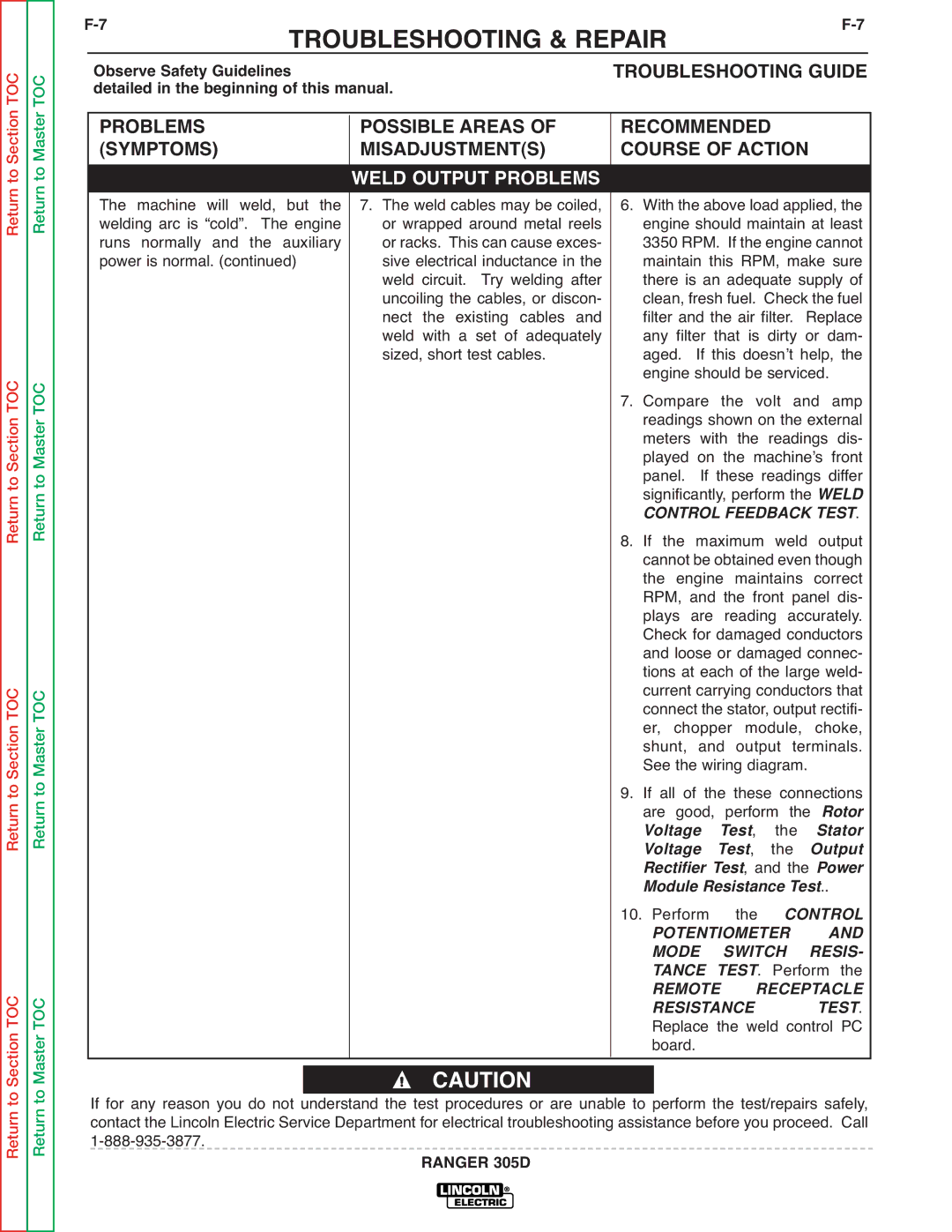
Return to Section TOC
Return to Section TOC
Return to Section TOC
Return to Section TOC
Return to Master TOC
Return to Master TOC
Return to Master TOC
Return to Master TOC
|
|
|
|
|
|
|
|
| ||||
| TROUBLESHOOTING & REPAIR |
|
|
|
| |||||||
| Observe Safety Guidelines |
|
|
|
| |||||||
| detailed in the beginning of this manual. |
| TROUBLESHOOTING GUIDE | |||||||||
| PROBLEMS |
| POSSIBLE AREAS OF |
| RECOMMENDED |
|
| |||||
|
|
|
|
| ||||||||
| (SYMPTOMS) |
| MISADJUSTMENT(S) |
| COURSE OF ACTION | |||||||
|
|
|
| WELD OUTPUT PROBLEMS |
|
|
|
|
|
|
| |
| The machine will weld, but the |
| 7. The weld cables may be coiled, |
| 6. With the above load applied, the | |||||||
| welding arc is “cold”. The engine |
| or wrapped around metal reels |
| engine should maintain at least | |||||||
| runs normally and the auxiliary |
| or racks. This can cause exces- |
| 3350 RPM. If the engine cannot | |||||||
| power is normal. (continued) |
| sive electrical inductance in the |
| maintain this RPM, make sure | |||||||
|
|
|
| weld circuit. Try welding after |
| there is an adequate supply of | ||||||
|
|
|
| uncoiling the cables, or discon- |
| clean, fresh fuel. Check the fuel | ||||||
|
|
|
| nect the existing cables and |
| filter and the air filter. | Replace | |||||
|
|
|
| weld with a set of adequately |
| any filter that is dirty or dam- | ||||||
|
|
|
| sized, short test cables. |
| aged. If this doesnʼt help, the | ||||||
|
|
|
|
|
|
| engine should be serviced. | |||||
|
|
|
|
|
|
| 7. Compare the volt and amp | |||||
|
|
|
|
|
|
| readings shown on the external | |||||
|
|
|
|
|
|
| meters with the readings dis- | |||||
|
|
|
|
|
|
| played on the machineʼs front | |||||
|
|
|
|
|
|
| panel. If these readings differ | |||||
|
|
|
|
|
|
| significantly, perform the WELD | |||||
|
|
|
|
|
|
| CONTROL FEEDBACK TEST. | |||||
|
|
|
|
|
|
| 8. If the maximum weld output | |||||
|
|
|
|
|
|
| cannot be obtained even though | |||||
|
|
|
|
|
|
| the engine | maintains | correct | |||
|
|
|
|
|
|
| RPM, and the front panel dis- | |||||
|
|
|
|
|
|
| plays are | reading accurately. | ||||
|
|
|
|
|
|
| Check for damaged conductors | |||||
|
|
|
|
|
|
| and loose or damaged connec- | |||||
|
|
|
|
|
|
| tions at each of the large weld- | |||||
|
|
|
|
|
|
| current carrying conductors that | |||||
|
|
|
|
|
|
| connect the stator, output rectifi- | |||||
|
|
|
|
|
|
| er, chopper | module, | choke, | |||
|
|
|
|
|
|
| shunt, and | output terminals. | ||||
|
|
|
|
|
|
| See the wiring diagram. | |||||
|
|
|
|
|
|
| 9. If all of the these connections | |||||
|
|
|
|
|
|
| are good, perform the Rotor | |||||
|
|
|
|
|
|
| Voltage | Test, | the | Stator | ||
|
|
|
|
|
|
| Voltage | Test, | the | Output | ||
|
|
|
|
|
|
| Rectifier Test, and the Power | |||||
|
|
|
|
|
|
| Module Resistance Test.. | |||||
|
|
|
|
|
|
| 10. Perform |
| the | CONTROL | ||
|
|
|
|
|
|
| POTENTIOMETER | AND | ||||
|
|
|
|
|
|
| TANCE TEST. Perform the | |||||
|
|
|
|
|
|
| MODE | SWITCH | RESIS- | |||
|
|
|
|
|
|
| REMOTE | RECEPTACLE | ||||
|
|
|
|
|
|
| Replace the weld control PC | |||||
|
|
|
|
|
|
|
| ESISTANCE |
| TEST. | ||
|
|
|
|
| CAUTION |
| board. |
|
|
|
| |
|
|
|
|
|
|
|
|
|
|
|
| |
| If for any reason you do not | understand the | test procedures or are unable to | perform the test/repairs safely, | ||||||||
| contact the Lincoln Electric Service Department for electrical troubleshooting assistance before you proceed. Call | |||||||||||
|
|
| RANGER 305D |
|
|
|
|
|
|
| ||
|
|
|
|
|
|
|
|
|
|
|
| |
